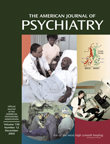In this issue, Donald S. Kornfeld, M.D., provides a historical review of some of the major contributions of consultation-liaison psychiatry to the practice of medicine.
As noted by Kornfeld, The American Board of Psychiatry and Neurology (ABPN) recommended subspecialty status for consultation-liaison psychiatry—renamed “psychosomatic medicine”—in October 2001. In June 2001, the American Psychiatric Association Board of Trustees had voted to support the application after a convincing presentation by Thomas Wise, M.D., representing the Academy of Psychosomatic Medicine.
In the spring of 2003, the ABPN recommendation will be acted on by the American Board of Medical Specialties. If approved, as expected, the first certificate would likely be awarded in 2005.
Psychosomatic medicine would thus become the seventh subspecialty available to psychiatry diplomats of the ABPN.
Child psychiatry was the first psychiatric subspecialty (1959), and to date a total of 5,142 child and adolescent certificates have been awarded. In the early 1990s, three additional psychiatric subspecialties were approved (accompanied by the year the certificates were first awarded and by the number of individuals since certified): geriatric psychiatry (1991, N=2,595), addiction psychiatry (1993, N=1,854), and forensic psychiatry (1994, N=1,384)(S. Scheiber, personal communication, 2002).
Two other subspecialties are also available to psychiatrists certified by ABPN (clinical neurophysiology and pain medicine), but the number of psychiatrists certified in these subspecialties is low (N=21 and 25, respectively).
Increased subspecialization in psychiatry has been viewed critically by some who have expressed concerns about fragmenting the field, weakening the generalist, increasing the cost of care, and undermining core graduate education
(1,
2). Others, including Yager
(3) and Shore
(4), have convincingly argued that subspecialization is desirable and strengthens the field. The voluminous amount of new knowledge makes it difficult for the generalist to stay abreast of developments in complicated areas, such as transplantation medicine. Accredited subspecialty fellowship programs increase focus, scholarship, and research in selective areas; increase the stature and influence of the subspecialist in academic centers; and may positively affect decisions about reimbursement in areas of special expertise.
Subspecialization requires a significant body of scientific knowledge and research and a clearly demonstrated need for the subspecialists’ expertise. Kornfeld, a major contributor to this literature for over four decades, highlights the clinical research and teaching that has characterized consultation-liaison psychiatry since 1950. His examples—postoperative delirium, the impact of depression on myocardial infarction and stroke outcomes, the psychological impact of cancer and cancer surgery, issues of organ transplantation, sleep deprivation in residents, patients signing out against medical advice, and many other clinical issues—remind us of the critical advances in medical care that have resulted from the involvement of consultation-liaison psychiatrists. Studies such as those on depression as a risk factor for cardiovascular and cerebrovascular disease included in a recent American Heart Journal supplement
(5) underscore the potential impact of extending the pioneering work described by Kornfeld. If space had permitted, Kornfeld might have included areas where consultation-liaison psychiatrists have also made significant contributions to clinical care, such as rheumatology, endocrinology, and immunology. Kornfeld briefly draws attention to the involvement of and potential for consultation-liaison psychiatrists in primary care (an area where psychiatry’s involvement is rapidly and appropriately expanding), genetics, clinical ethics, and end-of-life care.
Supporting the appropriateness of subspecialty status is the reality that consultation-liaison psychiatry is served by three national subspecialty organizations and supports at least three major subspecialty journals. The time appears right for subspecialty status for consultation-liaison psychiatry.
McKegney et al.
(6) made an interesting argument that consultation-liaison psychiatry should be considered “a supraspecialty” rather than a more narrowly defined subspecialty, since consultation-liaison psychiatry is significantly involved in many of the “subspecialty” areas in psychiatry and throughout psychiatry as a whole.
The name of this subspecialty has been debated for years, and the choice of the name “psychosomatic medicine” will not end the discussion. In 1992, Thompson surveyed 210 psychiatrists (approximately one-half were members of the Academy of Psychosomatic Medicine, and the remainder were other educational and clinical leaders of American psychiatry selected by Thompson)
(7). The preferred names in this informal survey were “medical-surgical psychiatry” and “consultation-liaison psychiatry.” “Psychosomatic medicine” was not a high pick of those surveyed by Thompson and for good reason. First used by Heinroth, the term “psychosomatic” does emphasize the hopefully integrated focus on mind/soul and body, has a rich history in the pioneering work of psychoanalytic clinicians in the mid third of the 20
th century, and for 42 years has been the title of a major journal in the field. However, I am confident that many psychiatrists would still agree with Sir Aubrey Lewis that “psychosomatic” denotes an ill-defined area of interest with poorly defined boundaries. For some, the name implies causation. Others will note that it does not convey the range of activities and the current nature of the clinical work of the consultation-liaison psychiatrist. Some may ask, why “psychosomatic medicine”? Why not “psychosomatic psychiatry”? Admittedly, the term “consultation-liaison” and the long list of other names that have been considered also present many difficulties.
Hopefully, going forward, the chosen name will increasingly convey the richness of the clinical work and the depth of scholarship and scientific inquiry that characterize the current endeavors.
Last, a few thoughts about teaching, which has been central to the mission of consultation-liaison psychiatry. Kornfeld describes the efforts to “infuse medical education—from medical school through residency training—with bedside teaching in which physicians learn to better understand their patients and themselves.” In Rochester, Engel and Romano nurtured the idea that in all branches of medicine, an informed, disciplined and caring patient-doctor relationship is at the heart of treating and healing patients.
Consultation-liaison psychiatry has indeed made, and continues to make, major contributions to the practice of medicine and the education of physicians. Whatever its name, its best days lie ahead.

